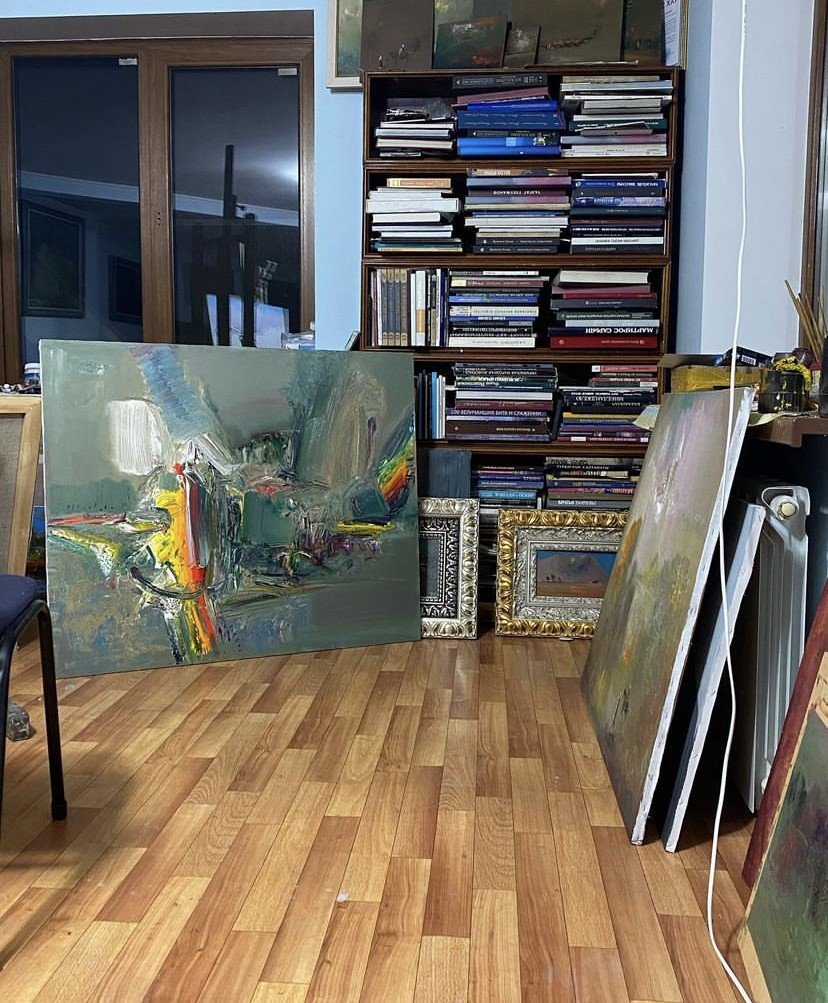Secrets of the Steppe VI: The Fine Art of McDonald’s
Мираж в степи. Макдоналдс. @alpysbaikazgulov on Instagram, posted 21/09/2022.
Like most third year MMLer’s, I spent the majority of my winter holidays panicking about my Year Abroad Project. It’s quite overwhelming to have the freedom of writing about quite literally anything you want, and so – in an attempt to give myself a sense of direction – I was pretty determined to do something involving Kazakhstan. I mean, I’m here for a full year. Surely I would come up with something in that time, right?
Thankfully, this is where the Kazakh affinity for social media helped me out. Like most of my generation, I can spend a fair amount of time scrolling through Instagram, and with an algorithm as quick as this platform’s, it was only a matter of time until I was flagged as a willing consumer of Kazakh art and literature. This is where I first came across the work of Alpysbai Kazgulov. I could fib and say that the first thing that caught my eye was his eclectic use of colour, his innovative blending of the abstract with the figurative, or the stunning steppe landscapes. Unfortunately, though, I can’t claim such an impressively academic reaction. The first thing that caught my eye was McDonald’s.
Мираж в степи. Макдоналдс. (2022) (Mirage on the Steppe. Mcdonald’s) could be argued to take inspiration from a long history of paintings by similar names (at least the first part anyway). However, the early 20th century paintings of Varfolomeevich and Kuznetsov are much more what you’d expect from the name: simple, figurative, neutral-toned images of nomadic life. They’re nothing like Kazgulov’s contemporary interpretation of modern-day oasis from the harsh grassland-desert landscape.
Pavel Kuznetsov’s 1911 work В Степпе. Мираж (In the Steppe. Mirage), Public Domain via Wikimedia Commons
This painting depicts the steppe at sunset: waves of dusky crimson-blue blend with clouds of violet, and the landscape is formed in a dream-like, whirlwind stroke-pattern reminiscent of impressionism. The hazy movement of the background along with its dark, cool tones celebrate the awesome beauty of the steppe along with it’s cruel power: a warning of a freezing, lonely and lethal night. The oasis at the centre of this? The contrastingly warm, golden light radiating from a McDonald’s. Moreover, the store itself is set apart in its entirely figurative, realistic depiction: golden arches, red boarding and even a neat, completely legible restaurant name. Ironically, the ‘mirage’ is the only thing that appears concrete.
What struck me most about the painting was its complete duality and blending of two canonically different modes of life. We see a caravan of camels in the car drive thru; people dressed in chinos instead of the expected traditional national dress; and a fast food chain in the place of a natural oasis. Moreover, the blurring of boundaries between these two sides of Kazakh life was totally enthralling. Just as Kazgulov refuses to engage in any one artistic ‘-ism’, he also rejects the idea of engaging in any spatial or temporal separation of Kazakh identity, instead celebrating it as a timeless whole. I was enthralled by how un-pretentious this piece was in making such a grand statement.
Timelessness is absolutely key to this artist’s works. Whether it is placed centre stage in surreal paintings like Время (Time) , in which a Dali-esque Rolex floats in the sky before melting into the infinite steppe, or is more subtly tackled in paintings that address the artist’s memory (his personal series focussed on his childhood home, or his national series based on the fierce, cavalier ancestors of the Kazakh people), - time is central. His art contains an imperative to forward movement through time, whilst never forgetting the importance of that which has been and gone.
I found this really refreshing in a country where the majority of other contemporary artists either purely celebrate the past, or celebrate the past and then mourn the future. (NB: If you’d like an example, I can recommend Konyrtai Mukhamediev – take a look at his 2022 trilogy: Наследие предков, Независимость and Апокалипсис - Ancestral Heritage, Independence and Apocalypse).
Undoubtedly my favourite thing about Kazgulov is his optimism.
Image from the artist’s Instagram, captioned ‘Creativity for the night’ and posted on 22/2/2022
You can imagine my disappointment then when, inspired to do some research, I immediately came across a critic who lamented Kazgulov’s heartbreaking depiction of the destruction of historically imagined Kazakh identity by modern consumerism. This is where my previous article (and slight desire to prove an academic wrong) comes back in. Like I said, I’d first come across his work on Instagram. Now knowing that no person (or restaurant/bar/club) is ever as perfect as they seem on their profile, I forced myself to look past the links to TV talk show appearances and the photos of men in smart suits at gallery openings. I decided to message him.
The next thing I knew, Alpysbai Kazgulov was not only answering my questions, but inviting me to his studio to interview him. Incredibly cool, but incredibly terrifying. It turns out that despite my social media enlightenment one can still absolutely get star struck, even over tea and biscuits with a really lovely old man. I was so nervous I briefly genuinely forgot how to speak Russian. Despite my broken speech, though, I got the answers I was searching for and can now confidently say – despite what some critics may have said - that this artist, like most (and I’m sure, like the critics that have admired Kazgulov’s “lamentation of modernity”) , has both a taste for enriching national identity and for the occasional Big Mac.


